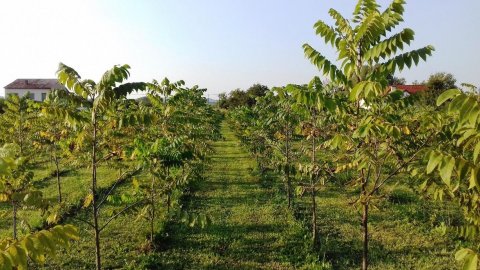Black walnut is a combination of perspective fast-growing tree, which provides a very valuable wood biomass and forgotten fruit tree with edible, tasty and nutritious nuts (Photo: M. Pástor)
In agriculture of the Slovak Republic, during the transition of this sector to the bioeconomy and to the principles of the "European Green Deal", agroforestry systems will play an important role in solving the current problems, especially in marginal areas, where compared to traditional agricultural systems, they can provide higher incomes to farmers, give a job opportunities for inhabitans of rural areas. At the same time, they represent a significant mitigation measure on climate change.
A significant shift towards the acceptance and legalization of agroforestry systems has taken place in Slovakia in recent years. Thanks to the activities of National Forest Centre staff, agroforestry has already been included in several strategic materials of the Ministry of the Environment and the Ministry of Agriculture and Rural Development of the Slovak Republic (Environment Strategy 2030, National Forestry Program, etc.) and its support is also declared in the current program statement of the Government of the Slovak Republic.
In Slovakia, we still have a large amount of neglected or poorly farming land. At the same time, the area of intensely managed land blocks is annually affected by climatic extremes and inappropriate management. The degradation of the agricultural landscape is a current process that is constantly being conducted with less or bigger intensity. Erosion, desertification, waterlogging, soil suppression, soil organic matter depletion and nutrient leaching into deeper horizons are degradation processes that can also help solve the establishment of agroforestry systems to agricultural practices.
Agroforestry systems are not mentioned in Slovak legislation yet, as there is no expert background and until now the issue of agroforestry systems has not been investigated. There is also a lack of agroforestry demonstration sites and knowledge about the cultivation and use of trees in agroforestry systems.
Researchers from the National Forest Centre have been working on agroforestry since 2014 and their long-term hard work in research and promotion of this issue, brought the first results. The Slovak Research and Development Agency financially supported the first agroforestry project entitled Research possibilities of the utilisation of black walnut (Juglans nigra L.) and chestnut (Castanea sativa Mill.) from a production-ecological aspect in agroforestry systems in Slovakia. This project is running from August 2021 to June 2025 and is lead by Dr. Michal Pástor. Second partner in the project is National Agricultural and Food Centre.
Black walnut and chestnut are suitable tree species for establishment of agroforestry systems, but up to now their potential for agroforestry systems for agricultural land management has not been used. For agribusiness they can be very interesting and perspective both in terms of nut production and high quality and well-rated wood on the market.

Chestnut orchard grazed by chickens is one of the research plot for long-term monitoring in the project (Photo: M. Pástor)
- elaboration of methodology for the establishment of agroforestry systems with black walnut and chestnut
- establishment of research-demonstration plots – agroforestry systems with black walnut and chestnut
- identification of areas of agricultural land suitable for growing black walnut and chestnut in agroforestry systems in Slovakia
- creation of regression models for determination of black walnut biomass and carbon sequestration in woody biomass through quantification of carbon stocks and their changes
- determine the mechanical properties of black walnut and chestnut by non-destructive methods as parameters for determining the possibilities of their use for special purposes
- proposals to modify national legislation to enable the development of agroforestry systems in Slovakia in line with EU law
Author: Michal Pástor












